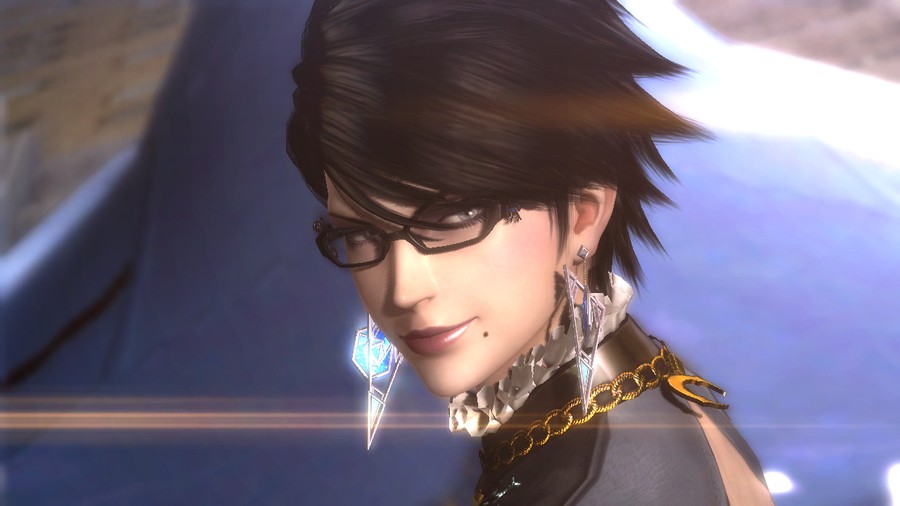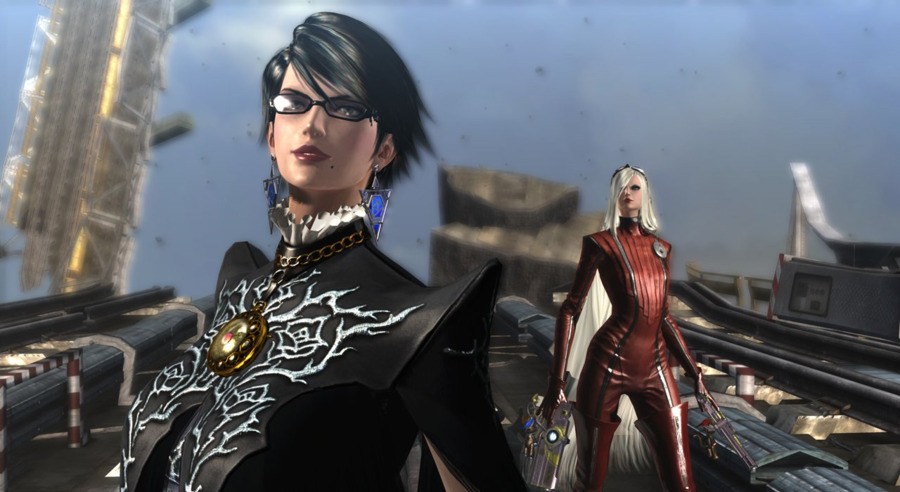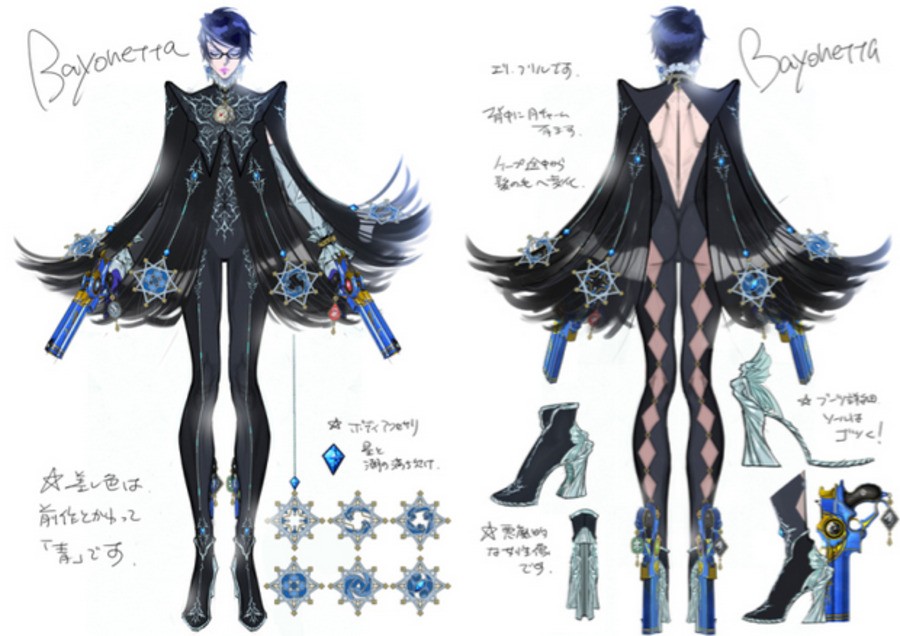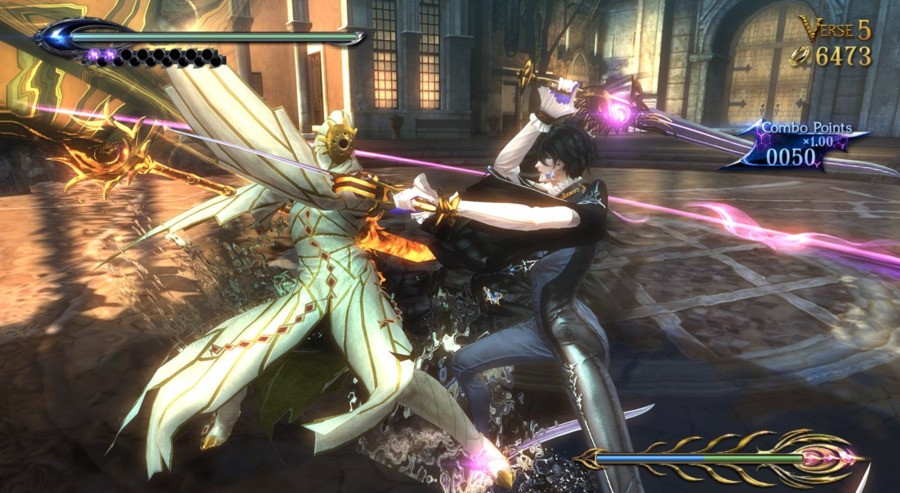
While it's a release that'll perhaps be battling the odds to make a major commercial impact, Bayonetta 2 will arrive as a Wii U exclusive on 24th October in the West, joined by an enhanced port of its predecessor. The new entry arrives as a relatively unique arrival, one of few dedicated action games of its type in the current market and undoubtedly a stand-out in its genre; it's been the recipient of critical acclaim, and was only one notch below perfect in our own review.
There's much about this franchise that helps it to distinguish itself from contemporaries, primarily Bayonetta herself. Producing a named hero to drive a franchise is a task rarely undertaken, simply because the development team in question must back themselves to successfully create a figurehead compelling enough to carry an entire IP. Platinum Games isn't a studio that seems to concern itself with too much self-doubt, however, and has brought us a character that is loved by many and attracts a share of criticism. In an era where so many key franchises are named after a 'universe', made up of many locations and featuring interchangeable casts, it's refreshingly bold.
It helps that the approach of Platinum Games, and Hideki Kamiya in directing the first title, was simply on producing a strong scenario above all else. Platinum Games' terrific blogs, covering the first and second game, give a little insight into the process — the following excerpt is from an entry from concept designer Ikumi Nakamura, titled The World of Bayonetta.
When making a game with Kamiya-san, the world view isn’t particularly locked down, so it is a fun experience. We can change how things are with each and every stage. However, there were a few things thematically within the Bayonetta world that were constants – Angels, Witches, the Sun, the Moon, etc. These motifs were unshakable. However, as we proceeded through the stages, we got excited creating the changes in architecture and culture that accompany them.

While we've been struck by the mix of European and fantastical architecture throughout these titles, we come to Bayonetta herself. A reason for the diverse opinions on her as a character is that she's a mass of contradictions — she's a sexy character that's constantly flirting with the game camera, with an exaggerated physique and hair that covers her body and promptly disappears when summoning demons. Yet she's also incredibly powerful, the focal point of the story with almost complete psychological and physical control over anyone and anything, be they a range of male characters or enormous screen-filling demons. Her relationship with Jeanne across both titles does bring out a softer, more vulnerable side, with the plot across the two entries also humanising her further. Interpretations of Bayonetta as a character sway between some analysis that she's a strong female figure, to others that decry her as a mere male fantasy — the middle ground is perhaps safer and closer to reality.
A key part of the brand is its unique look, and with Bayonetta as the heroine designer Mari Shimazaki followed a core brief from Kamiya-san — the following is from a blog post entitled Designing Bayonetta, focused on the first game.
When we started Bayonetta, our director, Hideki Kamiya, asked me to design a character with three traits:
1) A Female Lead
2) A Modern Witch
3) She Uses Four Guns...When a female character appears in an action game, her limbs often seem thin and short. That is why I tried to make her more appealing as an action game character by adjusting her proportions and extending her limbs.
Glasses! This was something that Kamiya-san really pushed for, as he was aiming to differentiate Bayonetta from other female characters and give her a sense of mystery and intelligence. Of course, I think it is just because he likes girls with glasses.
Conceptually, we were also looking to make Bayonetta “fashionable,” and I designed her so that this sense of fashion came through in all the little details, not just the glasses.
It's an interesting brief, while the description of designing the legs does address that part of Bayonetta's look. As for the sequel redesign, it reflects the same designer's desire — along with those leading the project — to evolve the character:

Bayonetta’s overall theme this time is “Solid.”
She’s still wearing black, and I think her shorter hair gives her a generally more masculine look. While her design in the last game focused on curves, this time we see more straight lines. All of her accessories follow this, except her glasses, which I gave a slightly softer design.
...Taking a step back and looking at how Bayonetta’s design turned out, I realize we went in a direction completely opposite from the last game. That also makes me think Bayonetta’s new look is possible because of her previous one, and will stand out because of that contrast.
I think she gives off a different impression than before, but still owns the name Bayonetta.
While Bayonetta fulfils her responsibility of carrying the IP, as we've suggested previously this is an evolving series that defines its unique approach in a variety of ways. While the first title had a muted palette and an overtly gothic approach, the sequel features brighter tones yet retains it sense of extraordinary design, clearly drawing from a variety of sources of inspiration, be they art, architecture or the vivid imaginations of the design team. Part of the appeal of Bayonetta 1 & 2, from our perspective, is that regardless of console or genre preference it strikes with such a clear sense of purpose and style as to set itself apart. It's not the only over-the-top third person action experience in the gaming world, but it feels like the only one of its specific type, which is not something that can always be said of many titles out in the market; we can often say X is just like Y, or is clearly inspired by Z. That's not so easy with Bayonetta.

Like Bayonetta herself, these games are a mass of delicious contradictions. The story is full of almost impenetrable lore yet is also easy to follow, while the combat can be intensely difficult while also being instinctive — extraordinary set pieces can still be boiled down to the core gameplay, regardless of the pyrotechnics on screen. What shines through is Platinum Games' crystal clear vision in turning these contradictions into a cohesive whole. We talk of the evolution — and in our view improvement — from Bayonetta to Bayonetta 2, yet they are best experienced in order as part of a growing series. In fact, we wholeheartedly agree with Hideki Kamiya's following advice from his Scenario Writing in Bayonetta 2 blog entry.
We have inherited the same Bayonetta flavor from the first game… no, that’s not quite right. The truth is, the two stories are inextricably linked; they are two sides of the same coin. For those of you who will be entering the world of Bayonetta for the first time, I highly recommend you play through Bayonetta before jumping into Bayonetta 2. To those handsome individuals among you who have already played through the first game, it wouldn’t hurt to play it again as a refresher.
Bayonetta 1 & 2 are both valuable parts of the gaming scene, in part because they spark debate but primarily because they're exceptions to the mainstream gaming rule. They shun a variety of design norms, which is their greatest strength.


Comments 31
Played the demo, and fell in love with the game just like I did with the first game back on the 360. I'm really glad that a sequel was possible. I will have to give Smash Bros and Persona Ultimax a break once Oct 24 gets here.
This is my most anticipated title of this year, by a wide margin. No matter how far I am in Hyrule Warriors' Adventure Mode, the day this releases HW goes on the back burner for a month or so.
There's only 1 thing that has to be said
Thank you Nintendo for resurrecting Bayonetta
"I think it is just because he likes girls with glasses"
One thing Kamiya and I have in common. I married a woman with a good eyesight though.
"t's a release that'll perhaps be battling the odds to make a major commercial impact,"
I'd say that statement is a definite truth in the UK. Other than on specific Nintendo gaming sites like this one, Bayonetta has had no exposure. Where are the prime time UK TV adverts? This game could definitely sell WiiU consoles.
This will be the game of 2014 and no doubt the game that takes me away from Hyrule Warriors and Mario Kart 8.
@HappyHappyist scary and awesome, but will always be there.
The SJW's out there hate this game.
I just see the Bayonetta movie, and not i'm in love more with the game
@OneBagTravel They like the fact the character design was by a women even less.
@Achoo Because I didn't think it was worth a 10, and I think 9 is a very high score. It's VERY simple.
Also, more sites gave it less than 10 than those that did, if we want to look at it factually.
I'm delighted it's been so well received in reviews though, it's a fantastic game.
I think its pretty nifty that even though they cut her hair i still see a witch's hat when I look at front and side shots of her. I'm not sure if it is due to the hair style or due to the fact that I know her previous hairstyle was supposed to represent a witches hat. I love visual nuances like that.
@BensonUii buy her some fake glasses. same effect...although i can imagine that will be an odd discussion...
I will say as now that my eyesight is failing I'm a little less into glasses than I used to be. Likely because I don't have the money to afford multiple nice frames to switch up in.
@Achoo To answer the first part, yes. We plan feature content for major releases in advance, and I don't care one jot what Metacritic something has when putting together content with the team; we follow our own priorities, not based on what review scores a game's had.
As for the New Super Mario Bros. Wii comparison, I didn't even work for the site when that was reviewed nearly five years ago. It's also an apples and oranges companion, plus a different reviewer etc.
@Achoo a 10 should be very difficult to earn as it is a perfect score. To be honest I don't think there is a such thing as a 10 game but i know most places aren't going to issue a 9.8 score or something like that.
9 is a great score. I know we all want this game to do well, especially the fans of the first one but let's not tear down positive reviews. I would think that Polygon's 7.5 would garner more ire.
@Achoo I agree I love Kotaku and Nintendo Everything's way of rating a game. Lengthy commentary and either a yes/no or a thumbs up/down. However, most people look at the score and not the content of the review. Heck, IGN is leaning towards more video reviews (which I'm not a fan of). Also, some devs get penalized and rewarded based upon metacritic scores... a non numerical score gets left out.
Also, most people don't read the scoring systems of video games so they think if it is not a 9 or 10 then the game is trash.
Not that reviews truly matter in the long run from a gamer's perspective. They are subjective by nature and rarely focus on the technical aspect of the game. If they did Bethesda games would all be scored in the 6 range due to the bugs. I personally wish more reviews would focus on how well a game works, as that is something that is less subjective. Let me decide if I like the story/characters/world.
*Please note I'm generalizing when I say most people.
this right here, Bayonetta 2, this is the kinda games Nintendo needs to get to their console! Played a demo of the game at a friends house and absolutely love this game! Might be the game that forces me to get a Wii U
I'm worried about the game...the game is almost out and there's not a single commercial uploaded to Nintendo's channel, that must mean no TV commercials.
For christ's sake Nintendo, word of mouth can only do so much! Start advertising your damn games...
Fire Iwata and Regie.
@Melkac There is a commercial actually. It's just unlisted right now on Nintendo's channel for whatever reason. The commercial plays on Adult Swim, which is the best place for the commercial to air.
https://www.youtube.com/watch?v=rH0OsWgJeyw
Buy the IP Nintendo, for the love of god. Getting this as a Wii U exclusive was the smartest thing you've done in years. We really need games such as this to balance out the Fisher Price fluff Nintendo seem to be all about these days.
This game is really going head to head with Smash Bros in terms of what I want to buy first. The more I see this game, the more I want to buy it before Smash Bros. I don't want to spend like $120 in one month on games, I need to save money for other things.
Arrggh! Maybe... I can get this game in the beginning of Nov and grab Smash in Dec...
Gettin it, gettin it, gettin it.
Seems like the perfect game for Halloween. Tried the demo earlier today and thought it was a lot of fun. I'm tempted to preorder and pick up at launch as there are not too many console games I'm interested in getting right now. The backlog may be getting put off soon in favor of these two games.
@IceClimbers Still not good enough. One TV advert (commercial) for the U.S. and none for UK or Europe. Melkac is right to protest as I did earlier on this thread. Only thing is that those decision makers in Nintedo HQ's in our various regions aren't listening!
I finally got a chance to play the demo last night. I'll be honest and say that it's not something I'm typically into and my first impression is that it's a button masher; but for some reason I really enjoyed playing it. I'm going to play through the demo a few more times before next week.
@Achoo What's your point?????
I happen to like New Super Mario Bros. U more then the demo of Bayonetta 2 (I know it's just a demo, but that's all I have to go off of). This proves that review scores are opinions only. I only look at scores if I'm on the fence about buying a game or not.
@dkxcalibur Same here, definitely felt like button mashing, but some elements of timing that were fun. Half the time I couldn't really figure out what was going on, but I can't say I didn't enjoy it. I did not expect her clothes to disappear so much during the fighting, which I found kind of gratuitous. I assume there's some game universe explanation for this? It seems like her clothes and her hair are intertwined with her attacks somehow? I could definitely tell that it was developed by the same folks who did Wonderful 101, which I also enjoyed, and which also fits every one of the knocks I describe above (gratuitous sexualization, button-mashing, rampant/confusing onscreen action). I've been on the fence about diving into Bayonetta because of an already huge backlog, but I like the relatively short length (of course, apparently I should play the first one too).
Ultimately, I think I'll probably end up buying the game, if for no other reason than to prove there is a market for non-first-party games on Wii U. The solid review scores, two-game pack in, and the intense demo have convinced me to overcome my sense of grown-up shame at playing a game where an impossibly proportioned woman repeatedly becomes naked while shooting giant demons with guns from her boot heels.
@earthboundlink Bayonetta's clothing is actually made out of her hair, as are her larger attacks, so when she needs to perform one of these big attacks she has to take all of the hair available to her to make it work.
I don't see a single logical issue with this.
@AlexOlney LOL, well that explains that. While it's still kind of gratuitous, at least there's an in-game explanation for her frequent nudity. I'm not knocking the concept (other than to note its gratuitousness, which you kind of understand and accept going into this kind of game), I'm just a n00b who didn't understand all of this based on the demo. I'm actually glad it's explained, and the whole "powerful woman clothed in her own hair" does have a very witchy vibe.
And really, while the hyper sexualization in the game may draw critics (I have my concerns, but think there are worse offenders than this game, which at least features a strong female lead), you don't hear too many people talking about the over-the-top blood explosions of the game, which are actually not even as bad as the gore and violence of other games.
And I'm getting pretty far afield in justifying my consideration of purchasing Bayonetta 2, but I think the real social problem of video games has less to do with random sex and violence than with the glorification of real, actual war. American commercials for Battlefield and Call of Duty and those types of games depict regular people having a blast killing people (often each other) in war zones, usually eating Burger King or Taco Bell or whatever fast food tie in the game has paid to get. That's a truly disturbing thing, and I can't believe people who have actually been in real wars don't say anything about it.
/rant
Waiting on the topics about how Bayonetta is disgracing females everywhere lol... smh...
One week, my love. Soon, we shall be reunited.
"t's a release that'll perhaps be battling the odds to make a major commercial impact,"
Maybe this quote is not so close to the mark - I Just got the following email from Game.co.uk
"Thank you for preordering Bayonetta 2 from GAME.co.uk
Due to the epic size of Bayonetta 2 we have a lot to do to make sure it gets to you on launch day! To help everything go smoothly for you, we will be processing your order and taking payment from Monday 20th October."
Now i'm guessing that the 'epic size' is referring to the number of the pre orders game are processing which is why they are taking payment four days prior to release.
Show Comments
Leave A Comment
Hold on there, you need to login to post a comment...